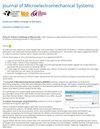具有尺寸匹配和响应平均电极的近无杂散6.5 GHz xbar
IF 3.1
3区 工程技术
Q2 ENGINEERING, ELECTRICAL & ELECTRONIC
引用次数: 0
摘要
铌酸锂(LiNbO3)横向激发体声波谐振器(xbar)在高频、宽带射频(RF)滤波器中显示出巨大的潜力。然而,抑制杂散模式响应仍然是一个关键的挑战。在这项研究中,我们使用尺寸匹配和响应平均电极展示了近无杂散的6.5 GHz Z-Y LiNbO3 xbar。对传统交叉换能器(IDT)电极尺寸的色散分析表明,当电极宽度对应于电极/LiNbO3板中二阶拟反对称(QA2) Lamb模式波长的一半时,杂散模式响应电平最小。这一结果在电极厚度范围内成立,并表现出对音高的弱依赖性。基于这些匹配的IDT维度,我们提出了三种新的IDT拓扑,它们采用响应平均策略来进一步减少杂散模式响应,而不会损害一阶反对称(A1) Lamb模式。所制器件与仿真结果吻合较好,具有低杂散响应和中等性能。这项工作为低杂散响应xbar提供了一个系统的设计框架,为更可靠和高效的下一代无线前端滤波器提供了一条途径。(2025 - 0070)本文章由计算机程序翻译,如有差异,请以英文原文为准。
Near-Spurious-Free 6.5 GHz XBARs With Dimension-Matched and Response-Averaged Electrodes
Lithium niobate (LiNbO3) laterally excited bulk acoustic wave resonators (XBARs) show great potential for high-frequency, wide-bandwidth radio frequency (RF) filters. However, suppressing spurious mode responses remains a critical challenge. In this study, we demonstrate near-spurious-free 6.5 GHz Z-Y LiNbO3 XBARs using dimension-matched and response-averaged electrodes. Dispersion analysis of traditional interdigitated transducer (IDT) electrode dimensions reveals that spurious mode response levels are minimized when the electrode width corresponds to half the wavelength of the second-order quasi-antisymmetric (QA2) Lamb mode in the electrode/LiNbO3 plate. This result holds across a range of electrode thicknesses and exhibits weak dependence on pitch. Based on these matched IDT dimensions, we propose three novel IDT topologies that employ response-averaging strategies to further reduce spurious mode responses without compromising the first-order antisymmetric (A1) Lamb mode. The fabricated devices show good agreement with simulation results, achieving a low-spurious response and moderate performance. This work provides a systematic design framework for low-spurious-response XBARs, offering a path to more reliable and efficient next-generation wireless front-end filters. [2025-0070]
求助全文
通过发布文献求助,成功后即可免费获取论文全文。
去求助
来源期刊

Journal of Microelectromechanical Systems
工程技术-工程:电子与电气
CiteScore
6.20
自引率
7.40%
发文量
115
审稿时长
7.5 months
期刊介绍:
The topics of interest include, but are not limited to: devices ranging in size from microns to millimeters, IC-compatible fabrication techniques, other fabrication techniques, measurement of micro phenomena, theoretical results, new materials and designs, micro actuators, micro robots, micro batteries, bearings, wear, reliability, electrical interconnections, micro telemanipulation, and standards appropriate to MEMS. Application examples and application oriented devices in fluidics, optics, bio-medical engineering, etc., are also of central interest.
 求助内容:
求助内容: 应助结果提醒方式:
应助结果提醒方式:


